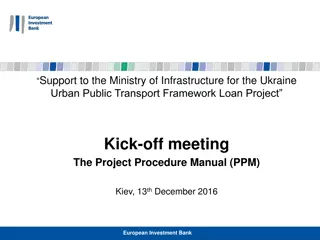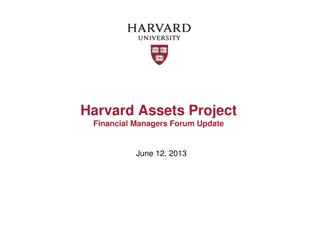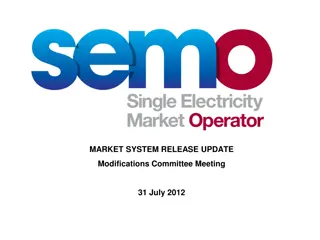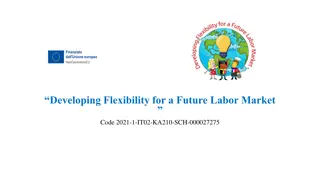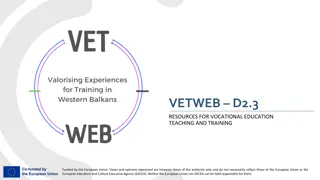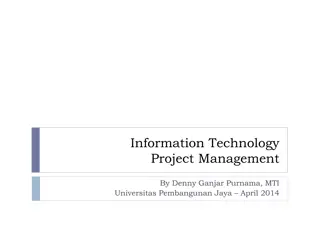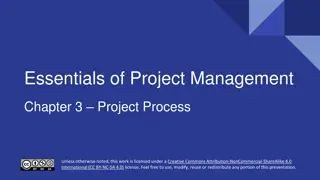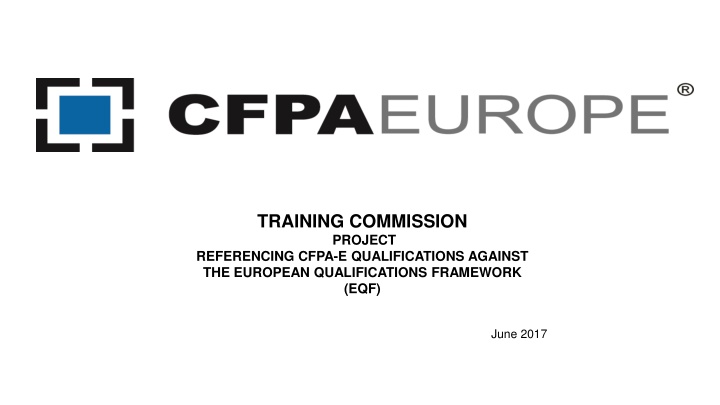
The European Qualifications Framework and CFPA-E Referencing
Explore the process of referencing CFPA-E qualifications against the European Qualifications Framework (EQF) to ensure transparency, relevance, and trustworthiness. Learn about the EQF, its benefits for learners, employers, and collaborations, as well as potential disadvantages. Discover the criteria set by the EQF Advisory Group and how to align qualifications independently before referencing to the EQF.
Download Presentation

Please find below an Image/Link to download the presentation.
The content on the website is provided AS IS for your information and personal use only. It may not be sold, licensed, or shared on other websites without obtaining consent from the author. If you encounter any issues during the download, it is possible that the publisher has removed the file from their server.
You are allowed to download the files provided on this website for personal or commercial use, subject to the condition that they are used lawfully. All files are the property of their respective owners.
The content on the website is provided AS IS for your information and personal use only. It may not be sold, licensed, or shared on other websites without obtaining consent from the author.
E N D
Presentation Transcript
TRAINING COMMISSION PROJECT REFERENCING CFPA-E QUALIFICATIONS AGAINST THE EUROPEAN QUALIFICATIONS FRAMEWORK (EQF) June 2017
Background Referencing CFPA-E qualifications against the European Qualifications Framework is not a prescriptive process but one that is designed to best fit the qualification framework that we design for our training. It is here where the main focus of the work has taken place to date. In the EQF guidelines on referencing they advise that the development of an (N)QF is a substantial political undertaking and a long term project for improvement rather than a short term means of better referencing to the EQF .
Ten criteria/procedures set by the EQF Advisory Ten criteria/procedures set by the EQF Advisory Group to guide the EQF referencing process Group to guide the EQF referencing process Their aim is to ensure that the information and documentation that sits behind our referencing process is a)Relevant b)Transparent c)Can be compared d)Generates trust This will allow the information to be judged as valid or not by those who are unfamiliar with our training system. Referencing reports from European countries can be seen at https://ec.europa.eu/ploteus/documentation
What is the European Qualifications Framework? A metaframework conceptual rather than tangible Descriptors for eight levels of learning A specific qualification can only be given an EQF level when it already has an agreed level within a recognised framework- commonly a National Qualifications Framework (NQF) Provides a common reference point between countries for levelling qualifications Facilitates comparison and recognition of qualifications
What benefits for us? Learners? Employers? Collaborations? A fresh approach? Others? And potential disadvantages? 5
How have we gone about it? Independently of the EQF we have had to: Decide what the CFPA-E qualifications framework looks like what levels of learning do we offer? Identify what criteria describe each of those levels in terms of knowledge, skills and attitudes Redesign our course descriptors, to include learning outcomes Level against our own framework Assigns points based upon length of programme THEN .. reference to the EQF 6
What are we aiming to achieve? A framework of qualifications grouped by functional area with clear progression pathways Each qualification will have clear learning outcomes which describe the level of learning Level of learning will be referenced to learning rather than length of programme Each qualification will be assigned a points value Points accumulated at a particular level could potentially be banked to achieve professional status Each qualification is referenced against the EQF 7
Starting with the CFPA-E Qualifications Framework: The Aim of the Framework is to provide an overview that: Specifies the relationship horizontally and vertically between different qualifications Shows how they are related to each other and how they are valued Provides a platform for communication, cooperation and dialogue between stakeholders, users and providers OUTCOMES: Reduction of the current 8 course groupings to 4 to improve clarity of relationships and simplify classification and dialogue Keeping Fire Safety; Security; Fire Protection Systems; Risk Management as the 4 Group headings
Risk Management - qualifications within this category develop knowledge, skills and abilities in identification, analysis, assessment, control, and avoidance, minimization, or elimination of unacceptable fire risks Business Continuity Planning Fire Risk Assessment Risk Management of Technical Safety Fire Risk Management Risk Management of Natural Hazards Principles of Fire Safety Engineering Performance Based Design for Fire Safety Fire Investigation Explosion (Prevention and protection in places where explosive atmospheres may occur) Classification of Explosive Hazardous Areas Explosion Protection Manager
Fire Protection Systems - qualifications within this category develop knowledge, skills and abilities in systems used in the control and mitigation of fire Sprinkler System: Basic Sprinkler Operator Natural Smoke & Heat Systems Operator Gas System Operator Fire Detection and Alarm Systems Operator Maintenance of Portable Fire Extinguishers Operator of Stationary Fire Protection Systems and Fire Extinguishers Containing Fluorinated Greenhouse Gases Installation and Inspection of Products for Passive Fire Protection in Buildings
Fire Safety qualifications within this category develop knowledge, skills and abilities in planning, organisation, control, monitoring and review of fire safety measures and fire safety provisions in premises Basic Fire Fighting and Fire Prevention Evacuation Steward Introduction to Fire Protection Management Systems Principles of Fire Safety at Work Fire Safety Technical Cycle Fire Safety Management Cycle Fire Safety During Construction Works Hot Works Fire Safety in Transformation Facilities Introduction to the Management of Hotel Fire Safety Fire Safety and Security: Museums and Historical Premises Specialist Fire Safety and Security: Shopping Centres Specialist Introduction to Thermography Thermography of Electrical Installations
Security - qualifications within this category develop knowledge, skills and abilities in planning, organisation, control, monitoring and review of fire security measures and provisions in premises Management of Key and Access Systems Perimeter Protection Systems Security Technical Cycle Security Management Cycle Certificated Security Manager Fire Safety and Security, Museums and Historical Premises Specialist Fire Safety and Security: Shopping Centres Specialist Physical Security Techniques CCTV Systems Intruder Alarm Systems
Deciding on knowledge, skills and attitudes relevant for CFPA-E levels CFPA-E, representing the majority of countries in the EU, has designed a structured series of qualifications that offer a framework of learning for professionals within the fire sector. They are intended to cover the key areas of knowledge and skills in a range of contexts. It is intended that their content is sufficiently generalised that they can be used within each country in a way that fits with that countries own NQF and NOS so that relevant linkages can be made. OUTCOME: It was agreed, rather than identifying new criteria for CFPA-E levels, that their qualifications should be referenced using level descriptors that are broadly the same as the EQF.
Deciding on which levels are relevant to the CFPA-E qualification system Each country has its own system for approaching induction to fire safety at a basic level ie Level 1 and it is not seen as the role of CFPA-E to include this level of learning within its own qualification framework. They may though offer guidance and support on best practice in this area. OUTCOME: CFPA-E s qualification framework starts at Level 2 CFPA-E s intention is to develop a qualifications system that incorporates the key topics relevant to fire protection and cover these topics to a depth that is required by significant numbers of individuals. It does not anticipate that its qualification framework will encompass knowledge at the most advanced frontier ie Level 8, although CFPA-E offer insights, guidance and support on best practice in this area. OUTCOME: CFPA-E s qualification framework offers learning at Levels 2-7 as defined by the EQF
Have Knowledge Able to demonstrate Skills Exercise Attitudes/Behaviours Highly specialised knowledge, some of which is at the forefront of knowledge of fire protection, as the basis for original thinking and/or research; critical awareness of the boundaries of that knowledge Manage and transform work or study contexts that are complex, unpredictable and require new strategic approaches ; take responsibility for contributing to professional knowledge and practice and/or for reviewing the strategic performance of teams Specialised problem-solving skills required in research and/or innovation in order to develop new knowledge and procedures and to integrate knowledge from different fields. LEVEL 7 Must be able to manage complex technical or professional activities or projects, taking responsibility for decision-making in unpredictable fire protection contexts; take responsibility for managing professional development of individuals and groups LEVEL 6 Must possess advanced skills, demonstrating mastery and innovation, required to solve complex and unpredictable problems in a specialised field of fire protection Must have advanced knowledge of a field of fire protection involving a critical understanding of theories and principles Must have a comprehensive, specialised, factual and theoretical knowledge within a field of fire protection and an awareness of the boundaries of that knowledge Must be able to exercise management and supervision in contexts of fire protection activities where there is unpredictable change; review and develop performance of self and others LEVEL 5 Must possess a comprehensive range of cognitive and practical skills required to develop creative solutions to abstract problems in a field of fire protection Must be able to exercise self-management within the guidelines of fire protection contexts that are usually predictable, but are subject to change; supervise routine work of others, taking some responsibility for evaluation and improvement of fire protection activities LEVEL 4 Must possess a range of cognitive and practical skills required to generate solutions to specific problems in a field of fire protection Must have factual and theoretical knowledge in broad contexts within a field of fire protection Must possess a range of cognitive and practical skills required to accomplish tasks and solve problems by selecting and applying basic methods, tools, materials and information LEVEL 3 Must have knowledge of facts, principles, processes and general concepts, within a field of fire protection Must be able to take responsibility for completion of tasks relevant to fire protection; adapt own behaviour to circumstances in solving problems Must possess basic cognitive and practical skills required to use relevant information in order to carry out tasks and to solve routine problems using simple rules and tools LEVEL 2 Must be able to work/study in the field of fire protection under supervision with some autonomy Must have basic factual knowledge of a field of fire protection V1 06.02.16
Moving on to look at the Levels of each CFPA- E qualification, the aim was to : make it possible for everyone to understand the relationships between different qualifications. to identify pathways and progression routes relevant to roles in the sector OUTCOMES: Completion of the work previously started by the TC, adding groupings for Security and Fire Safety to those already completed Extending the content of groupings in order to reduce the number of groups Levelling of each qualification against our established framework Redesign of the course descriptors for each qualification
CFPA-Europe qualification framework for Risk Management Target group: Level of qualification LEVEL 5 Managers; Prevention officers; specialists; Building Control Authority officers; inspecting officers; consulting engineers 1.7 Performance Based Design for Fire Safety 90 1.37 Fire Investigation 30 LEVEL 4 1.26 Business Continuity Planning 12 1.10 Risk Management of Natural Hazards 30 Executive and middle manager; specialists; safety managers; risk and consulting engineers; underwriters; consultants of insurers LEVEL 3 1.3 Fire Risk Management 30 1.11 Risk Management of Technical Safety 30 1.4 Fire Risk Assessment 30 1.8 Explosion Protection Manager 30 1.12 Principles of Fire Safety Engineering 30 Safety planners; fire safety/protection managers; advisors, consultants; risk engineers; contractors; insurers; install, design, control/monitor, maintenance companies; inspectors; surveyors 1.16 Classification of Explosive Hazardous Areas 12 Special Hazard and Processes Risk Assessment 1.15 Explosion (Prevention and Protection) 12 LEVEL 2 Operatives; supervisors; designers; departmental managers Existing CFPA Course Proposed CFPA Course No CFPA Course
CFPA-Europe qualification framework for Security Target group: Level of qualification LEVEL 6 Security senior managers; consultants/advisors of complex premises; enforcers specialising in security 1.33 Security Management Cycle 30 LEVEL 5 Staff responsible for organising security, security managers; security advisors 1.32 Certificated Security Manager 90 1.34 Security-Technical Cycle 30 LEVEL 4 Staff responsible for security; managers; consultants; manufacturers, distributors, installers and maintenance of security; inspectors LEVEL 3 1.5 Fire Safety and Security, Museums and Historical Premises Specialist 30 1.6 Fire Safety and Security: Shopping Centres Specialist 30 Technicians; staff responsible for security; consultants, planners; insurers; police authorities; private security companies; manufacturers, distributors, installers and maintenance of security; inspectors LEVEL 2 Staff responsible for administration of security systems; users, operators; manufacturers; advisors. 1.35 Management of Key and Access Systems 6 1.38 Physical Security Techniques 18 1.36 Perimeter Protection Systems 12 1.40 Intruder Alarm Systems 18 1.39 CCTV Systems 18 Existing CFPA Course Proposed CFPA Course No CFPA Course
CFPA-Europe qualification framework for Fire Safety Target group: Level of qualification LEVEL 6 Safety senior managers; advisors/consultants of complex companies; enforcers specialising in fire safety 1.1 Fire Safety - Management Cycle 60 1.2 Fire Safety-Technical Cycle 90 LEVEL 5 Safety managers; Consultants; enforcers; fire protection engineers 1.6 Fire Safety and Security, Shopping Centres Specialist 30 LEVEL 4 1.13 Principles of Fire Safety at Work 18 Safety managers; consultants; enforcers, insurers; fire protection engineers 1.24 Introduction to the Management of Hotel Fire Safety 6 1.5 Fire Safety and Security, Museums and Historical Premises Specialist 30 LEVEL 3 1.20 Fire Safety During Construction Work 6 1.9 Thermography of Electrical Installations 30 Technicians; installers; maintainers; commissioners 1.17 Fire Safety in Transformation Facilities 12 1.31 Introduction to Thermography 18 LEVEL 2 1.22 Introduction to Fire Protection Management Systems 6 1.25 Evacuation Steward 6 Operatives; fire wardens/marshals; departmental managers 1.19 Hot Works 6 1.23 Basic Fire Fighting and Fire Prevention 6 Existing CFPA Course Proposed CFPA Course No CFPA Course
CFPA-Europe qualification framework for Fire Protection Systems Target group: Level of qualification LEVEL 4 Gas ext. Systems Professional Installers, Experts, Control/Monitor ; Technical managers, Engineers/ architects, insurers, control/monitor, maintenance companies LEVEL 3 Sprinkler Professional FDAS Professional SHEV Professional Passive Fire Protection Professional Fire Protection Systems Advanced/Intermediate level Gas Systems Basics FDAS Basics SHEV Basics 1.21 Passive Fire Protection (Installation and Inspection) Basics 12 Technicians: User, Enforcers, Engineers/ architects, insurers; maintenance technicians 1.27 Sprinkler Systems Basics 12 1.18 Operator of Stationary Fire Protection Systems and Fire Extinguishers Containing Fluorinated Greenhouse Gases (EC-directive) 12 1.14 Maintenance of Portable Fire Extinguishers 24 LEVEL 2 1.28 Sprinkler Operator 12 1.41 Natural Smoke & Heat Exhaust Systems Operator 6 Maintenance company; staff working with water extinguishing systems; User personnel: operation and visual checks 1.29 Gas System Operator 12 Passive fire protection Systems Operator 1.30 Fire Detection & Alarm System Operator 6 Existing CFPA Course Proposed CFPA Course No CFPA Course
OUR AWARD FRAMEWORK 1- 6 hours of learning 7 29 hours of learning 30 + hours of learning Level 7 Attest Certificate Diploma Level 6 Attest Certificate Diploma Level 5 Attest Certificate Diploma Level 4 Attest Certificate Diploma Level 3 Attest Certificate Diploma Level 2 Attest Certificate Diploma
Points-based award framework showing hours of learning Certificate awarded for 7 29 HOURS/POINTS of learning at a specific level Length Basic Fire Fighting; Evacuation Steward; Fire Protection Management System; Sprinkler Operator; FDAS Operator; SHEVS Operator; Hot Works Attest awarded for UP TO 6 HOURS/POINTS of learning at a specific level Length LEVEL 2 Diploma awarded for 30 OR MORE HOURS/POINTS of learning at a specific level Length Qualification LEVEL 2 Qualification Qualification LEVEL 2 Sprinkler Operator; Gas System Operator LEVEL 3 Management of Key Access Systems; Construction Works LEVEL 3 Explosion Prevention / Protection; Perimeter Protection Systems; Sprinkler Systems Basic; Maintenance of Portable Fire Extinguishers; Installation of PFP; Operator of Stationary Fire Protection Systems; CCTV Systems; Physical Security Techniques; Intruder Alarm Systems; Classification of Explosive Hazardous Areas; Transformation Facilities; Introduction to Thermography LEVEL 3 Thermography Electrical Installations; Explosion Protection; Principles Fire Safety Engineering LEVEL 4 Introduction to Management of Hotel Fire Safety LEVEL 4 Business Continuity Planning; Principles Fire Safety at Work LEVEL 4 Risk Management of Technical Safety; Fire Risk Management; Natural Hazards; Fire Risk Assessment; Museums & Historical Premises; Shopping Centres LEVEL 5 Performance Based Design for Fire Safety; Fire Investigation; Security-Technical Cycle; Fire Safety-Technical Cycle;

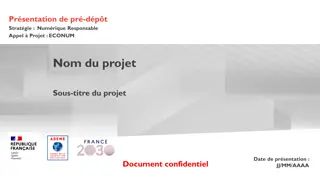
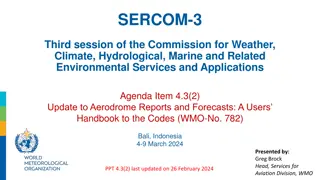






![Project Initiation Document for [Insert.Project.name] [Insert.Project.number]](/thumb/226757/project-initiation-document-for-insert-project-name-insert-project-number.jpg)

